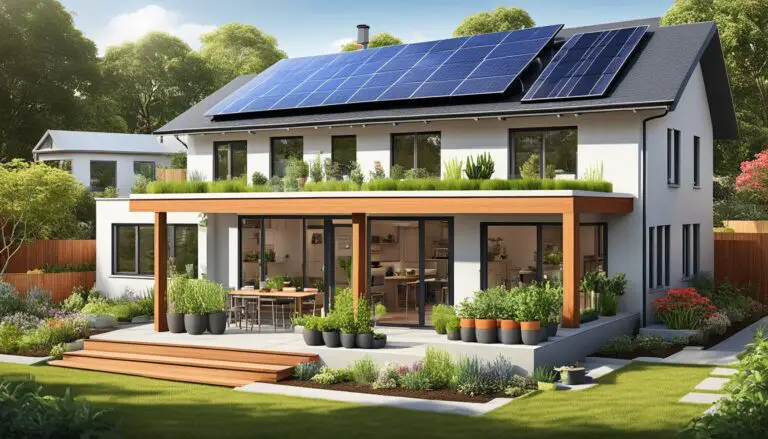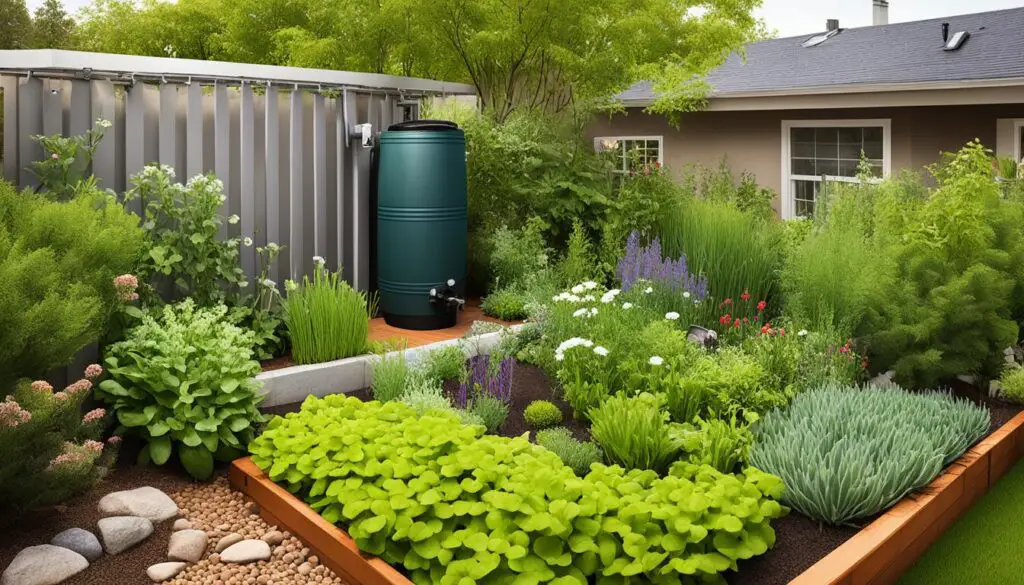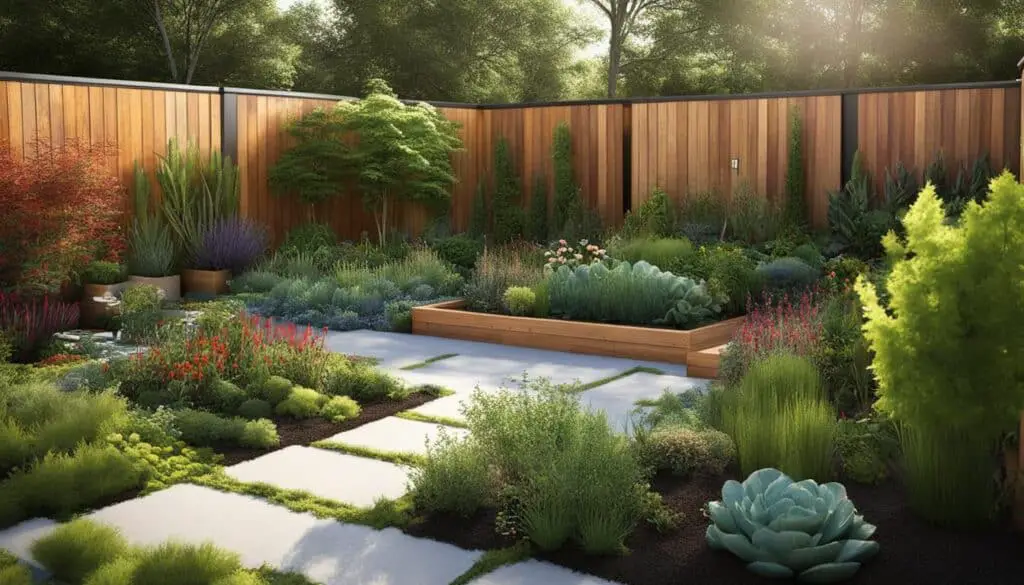Green home improvement projects are an excellent way to reduce your environmental impact and increase sustainability in your home. These projects focus on incorporating eco-friendly practices and materials into your home renovations, from energy-efficient appliances to sustainable building materials. By implementing these green initiatives, you can minimize your carbon footprint and create a more environmentally conscious living space.
Key Takeaways:
- Green home improvement projects help reduce your environmental impact and increase sustainability in your home.
- They focus on incorporating eco-friendly practices and materials into your home renovations.
- Energy-efficient upgrades, water conservation measures, and sustainable landscaping are key components of green home improvement projects.
- These projects offer numerous benefits, including energy savings, lower utility bills, and increased property value.
- By embracing green home improvements, you contribute to a greener, more eco-conscious future.
Benefits of Green Home Improvement Projects
Green home improvement projects offer numerous benefits for homeowners. By implementing these eco-friendly initiatives, you can not only reduce your environmental impact but also enjoy several advantages that go beyond sustainability.
Energy Savings and Lower Utility Bills
One of the significant benefits of green home improvement projects is the potential for energy savings. By incorporating energy-efficient appliances and fixtures, such as LED lighting and smart thermostats, you can significantly reduce your energy consumption. This, in turn, leads to lower utility bills, providing long-term savings while minimizing your carbon footprint.
Improved Indoor Air Quality
Green home improvements also focus on using sustainable building materials that enhance indoor air quality. For example, materials like bamboo flooring and recycled countertops not only contribute to a healthier living environment but also reduce exposure to harmful chemicals and pollutants that can be present in traditional building materials. By choosing these eco-friendly alternatives, you create a safer and more comfortable space for you and your family.
Increase Property Value
Another advantage of green home improvement projects is the potential to increase the value of your property. As more buyers prioritize sustainability and energy efficiency, homes with green features become more appealing. By investing in eco-friendly upgrades, you not only enjoy the benefits during your time in the home but also position yourself to attract eco-conscious buyers in the future.
Contributing to a Greener Future
Green home improvement projects enable you to actively contribute to a greener and more sustainable future. By reducing your environmental impact and carbon footprint, you play a part in mitigating the effects of climate change. These actions help create a healthier planet for current and future generations to enjoy.
Incorporating green home improvement projects into your renovation plans not only benefits you as a homeowner but also has a positive impact on the environment and the community as a whole. With the potential for energy savings, improved indoor air quality, increased property value, and a contribution towards a greener future, it’s clear that going green is a win-win for everyone involved.
Energy-Efficient Upgrades
Energy-efficient upgrades play a crucial role in green home improvement projects, prioritizing reduced energy consumption and sustainability. By incorporating these upgrades, you can actively contribute to a greener environment while also benefiting from long-term financial savings. Here are some examples of energy-efficient upgrades that can make a significant impact:
- Solar panels: Installing solar panels allows you to harness the power of the sun and generate clean energy for your home. This sustainable energy source not only reduces your reliance on traditional electricity but can also lead to substantial savings on your utility bills.
- Energy Star-rated appliances: Upgrading to appliances with the Energy Star label ensures high energy efficiency. These appliances are designed to consume less energy without compromising performance, resulting in lower energy usage and reduced environmental impact.
- Improved insulation: Enhancing insulation in your home prevents heat loss during winter and heat gain during summer. Effective insulation not only makes your living space more comfortable but also reduces the need for heating and cooling systems, ultimately leading to energy savings.
These energy-efficient upgrades not only help you reduce your carbon footprint but can also result in significant savings on your energy bills over time. By investing in these sustainable enhancements, you are actively contributing to a more environmentally conscious home and a brighter future.
Key Takeaways:
Energy-efficient upgrades are a key component of green home improvement projects, aiming to reduce energy consumption and promote sustainability.
Examples include installing solar panels, upgrading to Energy Star-rated appliances, and improving insulation.
These upgrades not only lower your carbon footprint but also lead to substantial savings on energy bills.
Improve your home’s energy efficiency and reduce your environmental impact with energy-efficient upgrades. The benefits extend beyond saving money – embracing sustainability in your home creates a more eco-friendly living space for yourself, your family, and future generations.
Water Conservation Measures
Water conservation measures are crucial components of green home improvement projects. By implementing these measures, you can help reduce water waste and promote efficient water use, contributing to the preservation of this precious resource. Incorporating water-saving techniques into your home can also alleviate the strain on local water supplies and ensure a more sustainable future.
There are several effective water conservation measures that you can adopt in your green home improvement endeavors:
- Installing low-flow showerheads and toilets: By replacing traditional fixtures with low-flow alternatives, you can significantly reduce water consumption without compromising on performance. Low-flow showerheads and toilets are designed to maintain adequate water pressure while minimizing water usage.
- Fixing leaky faucets and pipes: Even small leaks can waste a surprising amount of water over time. Regularly inspecting and promptly fixing any leaks in your plumbing system can prevent unnecessary water loss and preserve this valuable resource.
- Implementing rainwater harvesting systems: Rainwater harvesting involves collecting rainwater from rooftops and storing it for later use, typically for irrigation purposes. This practice not only conserves water but also reduces reliance on municipal water supplies.
By incorporating these water conservation measures into your green home improvement projects, you can make a significant impact on water usage and contribute to a more sustainable lifestyle.
| Water Conservation Measure | Description |
|---|---|
| Low-flow showerheads and toilets | Replace traditional fixtures with water-saving options that maintain adequate water pressure while reducing water consumption. |
| Fixing leaky faucets and pipes | Regularly inspect and promptly fix any leaks in your plumbing system to prevent unnecessary water loss. |
| Rainwater harvesting systems | Collect rainwater from rooftops and store it for later use, typically for irrigation purposes, to reduce reliance on municipal water supplies. |
Implementing these water conservation measures not only benefits the environment but also helps you save on water bills. By adopting sustainable water practices in your home, you can make a positive and lasting impact on the planet.
Sustainable Landscaping and Gardening
Sustainable landscaping and gardening play a crucial role in green home improvement projects. These practices focus on creating outdoor spaces that are not only visually appealing but also environmentally friendly. By implementing sustainable landscaping techniques and adopting eco-conscious gardening practices, you can reduce water usage, minimize maintenance needs, and enhance the overall sustainability of your home.
When it comes to sustainable landscaping, using native plants is key. Native plants are well-adapted to the local climate and require less water and maintenance compared to exotic species. They also provide a habitat for local wildlife, promoting biodiversity in your outdoor space. Additionally, native plants are often more resistant to pests and diseases, reducing the need for chemical pesticides.
Proper watering and mulching techniques are essential for sustainable landscaping. By maintaining an appropriate watering schedule and utilizing mulch around plants, you can reduce water evaporation and retain moisture in the soil, minimizing water waste and promoting healthy growth. Efficient irrigation systems, such as drip irrigation or rainwater harvesting systems, are also beneficial for sustainable landscaping, as they deliver water directly to the root zones of plants, maximizing water efficiency.
In sustainable gardening, composting plays a significant role in reducing waste and enriching the soil. Composting organic materials, such as kitchen scraps and yard waste, creates nutrient-rich compost that can be used as a natural fertilizer. By utilizing compost, you not only reduce the need for chemical fertilizers but also improve soil health and promote the growth of healthy plants.
Using organic fertilizers instead of synthetic ones further enhances sustainable gardening practices. Organic fertilizers are derived from natural sources and are free from harmful chemicals, making them safer for the environment and beneficial for soil health. They provide nutrients to plants gradually and improve the overall fertility of the soil over time.
Natural pest control methods are also essential in sustainable gardening. Instead of relying on chemical pesticides, consider using biological controls, such as beneficial insects or companion planting, to manage pests in your garden. These natural methods minimize the harmful impact on the ecosystem and create a balanced and sustainable environment for plants and beneficial insects to thrive.
By incorporating sustainable landscaping and gardening practices into your home improvement projects, you can create a beautiful outdoor space that aligns with your eco-friendly goals. From native plants to efficient irrigation systems, these practices not only reduce water consumption but also minimize reliance on harmful chemicals, improve soil health, and support local wildlife. Embracing sustainable landscaping and gardening is a meaningful step towards creating a greener and more sustainable future.
Conclusion
Green home improvement projects offer a wide range of benefits for homeowners, the environment, and future generations. By implementing energy-efficient upgrades, water conservation measures, and sustainable landscaping and gardening practices, you can significantly reduce your environmental impact and create a more sustainable home.
These projects not only provide immediate cost savings but also add long-term value to your property. By embracing green home improvements, you can enhance your living space while making a positive impact on the planet.
Reducing your carbon footprint and promoting sustainability contributes to a greener, more eco-conscious future. Take action today by incorporating green home improvement projects into your renovation plans. Together, we can build a better tomorrow.
FAQ
What are green home improvement projects?
Green home improvement projects focus on incorporating eco-friendly practices and materials into home renovations to reduce environmental impact and increase sustainability.
What are the benefits of green home improvement projects?
Green home improvement projects provide energy savings, lower utility bills, enhance indoor air quality, add value to your property, and attract eco-conscious buyers in the future.
What are energy-efficient upgrades?
Energy-efficient upgrades include installing solar panels, upgrading to Energy Star-rated appliances, and improving insulation in your home to reduce energy consumption and promote sustainability.
What are water conservation measures?
Water conservation measures focus on reducing water waste and promoting efficient water use, such as installing low-flow showerheads and toilets, fixing leaky faucets and pipes, and implementing rainwater harvesting systems.
What is sustainable landscaping and gardening?
Sustainable landscaping and gardening involve creating environmentally friendly outdoor spaces with native plants, efficient watering and mulching techniques, and implementing organic fertilizers, composting, and natural pest control methods.
Why should I consider green home improvement projects?
By implementing energy-efficient upgrades, water conservation measures, and sustainable landscaping and gardening practices, you can significantly reduce your environmental impact, create a more sustainable home, and enjoy immediate cost savings while adding long-term value to your property.



